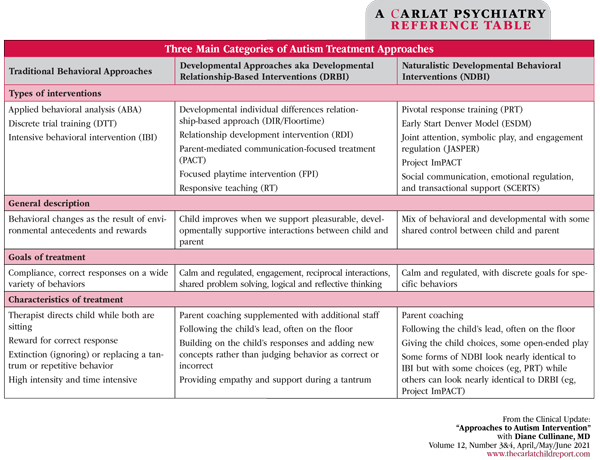Approaches to Autism Intervention
The Carlat Child Psychiatry Report, Volume 12, Number 3&4, April 2021
https://www.thecarlatreport.com/newsletter-issue/ccprv12n3-4/
Issue Links: Learning Objectives | Editorial Information | PDF of Issue
Topics: ABA | Applied Behavioral Analysis | Autism | Developmental Relationship Based Intervention | DRBI | Free Articles | Naturalistic Developmental-Behavioral Intervention | NDBI | treatment
Diane Cullinane, MD. Developmental pediatrician. Co-founder and Executive Director Emerita of Professional Child Development Associates (PCDA), Pasadena, CA. Dr. Cullinane has disclosed no relevant financial or other interests in any commercial companies pertaining to this educational activity. As clinicians, we are often faced with questions from families about the “best” program for autism intervention. While children with autism may receive a range of services including speech and language therapy, occupational therapy, and social skills help, some in the community, the anchor to most programs is some form of behavioral health treatment. This article will help you understand the main options for this kind of care and help you advise families on how to proceed. Three main approaches to autism intervention In addition, see below for a summary table of these interventions, meant as a start at understanding these different treatments. We recommend that clinicians learn more from the organizations that train and deliver these treatments. Evidence of efficacy Time investment Cost and availability of treatment Questions from families CCPR Verdict: Choice of autism intervention is not a one-time decision. It’s an ongoing process of monitoring and evaluation. Any program may be more or less effective depending on the skills of the particular interventionist as well as the match to the family and the developing child. Together, you can guide families in navigating these complex decisions. Table: Three Main Categories of Autism Treatment Approaches
Your patient is a young child who has recently been diagnosed with autism. Her parents are asking about the available treatments, and in particular, they want to know whether they should pursue the 40-hour-per-week program recommended by the local autism society.
In the past couple of decades, the field of autism intervention has evolved into three main evidence-based approaches. Here’s a brief synopsis of each:
The most recent edition of The National Clearinghouse on Autism Evidence and Practice supports specific practices that fall within all three of these main branches of autism intervention (Steinbrenner JR, Hume K, Odom SL, et al. Evidence-Based Practices for Children, Youth, and Young Adults With Autism. Chapel Hill, NC: National Clearinghouse on Autism Evidence and Practice; 2020). The American Academy of Pediatrics also endorsed all three interventions in their recent guidelines (Hyman S et al, Pediatrics 2020;145(1):e20193447). While there are thousands of studies on ABA, recent reviews recognize the growing body of research legitimizing DRBI and NDBI and showing that both of these have demonstrable effect sizes for social communication, while these effect sizes have not been shown for ABA (Sandbank M et al, Psychol Bull 2020;146(1):1–29).
While mostly focused on younger children, ABA and DRBI approaches are used for children of all ages and abilities and any behavioral challenge. NDBI is more narrowly focused on children 12 and younger. Direct DRBI is usually provided for fewer hours per week than ABA, with parents implementing the model throughout the week, which naturally extends the child’s engagement in the therapeutic process. While DRBI may also employ some additional hours with an interventionist to expand the range of people and experiences the child is exposed to, on balance DRBI requires less time and cost in most cases.
The Affordable Care Act mandates that all commercial insurance companies and Medicaid must provide “behavioral health treatment” for autism. Many insurance companies interpret this to mean ABA; however, all evidence-based treatments are included. Though you should direct families to go to their insurance company and ask for the treatment they desire, keep in mind that the choice of intervention approach may be dictated by the available funding source and options available in their community, rather than the best fit for the child and family. Traditional ABA has been easier to obtain with insurance, but developmental options are becoming more available. Good informed consent means the family knows their options. Advocate for their preferred treatment.
As the child’s clinician, your biggest task will most likely be helping the family sort through available treatment options to try and find the best fit for their needs. These common questions and answers should help you respond in a helpful manner.
![]() To learn more, listen to our podcast, “Approaches to Autism Intervention.” Search for “Carlat” on your podcast store.
To learn more, listen to our podcast, “Approaches to Autism Intervention.” Search for “Carlat” on your podcast store.



